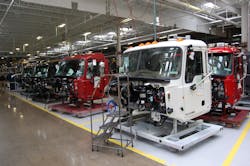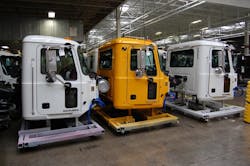Class 8 orders keep slipping in April
Class 8 orders dropped 39% in April on a year-over-year basis and declined 16% sequentially, according to preliminary data tracked by ACT Research Co.
By contrast, medium-duty truck orders remained relatively “healthy,” noted Kenny Vieth, ACT’s president and senior analyst; down 10% sequentially but up 12% year-over-year.
In raw numbers, ACT said Class 8 orders reached 13,700 units in April, while orders for Class 5-7 trucks topped 20,100 units.
“Despite increasingly easy year-over-year comparisons, demand for Class 8 vehicles continued to lose traction in April,” Vieth said in a statement.
He added that the “drivers of soft Class 8 demand” remain intact from previous months: overcapacity resulting weak freight rate environment; softness in late-model used truck values; and excessive new vehicle inventory.
John Larkin, managing director and head of transportation capital markets research at Stifel Financial Corp., noted in a recent market update that motor carriers have, for the most part, backed off on capacity additions.
“With a few exceptions, carriers have canceled orders for incremental tractors and trailers,” he said. “Instead, carriers are intensely focused on improving equipment utilization and revenue yield, even though rate increases will be hard to come by.”He added that revenue yield improvements will likely be driven more by customer selection, lane selection, and lane balance initiatives rather than via “classical” freight rate increases.
Research firm FTR noted that Class 8 orders have annualized to “a paltry” 190,000 units over the past three months, with the annualized rate hovering at 237,000 units for the last 12-month period.
“Class 8 orders were once again below expectations with the downshift in order activity continuing,” said Don Ake, FTR’s vice president of commercial vehicles, in a statement.
“It looked like the market was going to stabilize, but this order volume is surprisingly low,” he added.
Echoing Larkin’s analysis, Ake pointed out that fleets have “right-sized” for current freight volumes and do not need additional Class 8 units.
“OEMs will not be able to maintain current build rates under these order conditions [and] it appears more production cuts are on the way,” he said. “Backlogs are quickly shrinking and are expected to fall below 2014 levels relatively soon. A big order month could stop the bleeding, but we are entering the ‘summer slump’ so [Class 8] order activity will probably get worse before it gets better.”
By contrast, medium duty demand remains “bolstered” in ACT’s view by a number of macro-economic factors: a decent jobs market; rising incomes, which support discretionary spending; plus improved housing and automotive sales activity.

